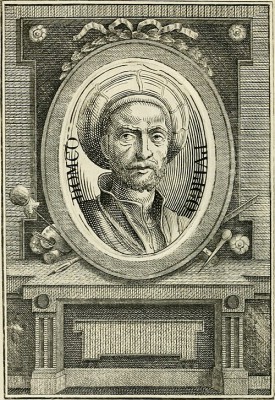
Domenico Puligo, born Domenico di Bartolomeo Ubaldini in Florence in 1492, stands as a significant, if sometimes overlooked, figure in the vibrant artistic tapestry of the Italian Renaissance. Active primarily in his native city, Puligo's career, though tragically cut short, reveals an artist adept at absorbing the innovations of his illustrious contemporaries while forging a distinctive style characterized by its gentle sfumato, harmonious color palettes, and tender emotionality. His oeuvre, predominantly consisting of religious subjects and portraits, offers a window into the devotional practices and aesthetic preferences of early sixteenth-century Florence, a city at the zenith of its artistic prowess. Understanding Puligo requires situating him within the dynamic workshop traditions and the stylistic currents that defined this fertile period, particularly the transition from the High Renaissance to the nascent stirrings of Mannerism.
Early Life and Formative Training
Born into a family of artisans – his father, Bartolomeo, was a blacksmith of the Ubaldini lineage – Domenico Puligo's path into the world of painting began at a relatively young age. Around the age of twelve, he entered the workshop of Ridolfo Ghirlandaio (1483–1561). Ridolfo, son of the even more famous Domenico Ghirlandaio (1449–1494), was a respected master in his own right, known for his solid draftsmanship and continuation of the Ghirlandaio workshop's reputation for quality and reliability. Under Ridolfo's tutelage, Puligo would have received a thorough grounding in the fundamentals of Florentine artistic practice: drawing from life and from revered masters, grinding pigments, preparing panels, and the principles of composition. This early training instilled in him a respect for craftsmanship and a foundational understanding of the prevailing artistic language of Florence, which still bore the strong imprint of late Quattrocento masters.
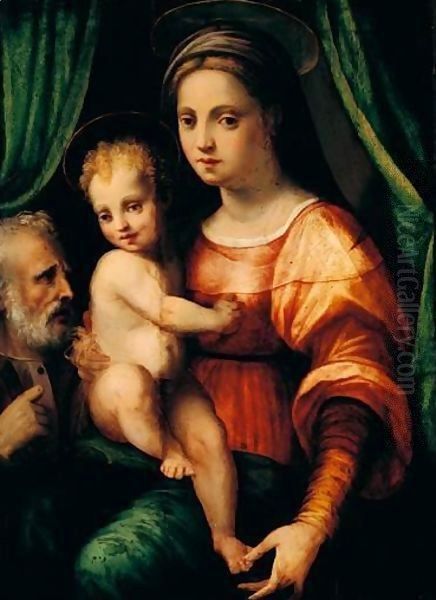
The workshop of Ridolfo Ghirlandaio was a bustling environment, and Puligo would have been exposed to a variety of commissions, from altarpieces to private devotional paintings and portraits. This period was crucial for developing his technical skills and his ability to work within established iconographic traditions. The influence of the Ghirlandaio workshop, with its emphasis on clear narrative and pleasing, well-ordered compositions, can be discerned in the underlying structure of Puligo's later works, even as he developed a more personal and nuanced style.
The Pivotal Influence of Andrea del Sarto
While his apprenticeship with Ridolfo Ghirlandaio provided a solid foundation, it was Puligo's subsequent association with Andrea del Sarto (1486–1530) that proved to be the most transformative influence on his artistic development. Del Sarto, often dubbed "the faultless painter" ("senza errori") by his contemporaries, was a leading figure of the Florentine High Renaissance, celebrated for his sophisticated use of color, masterful sfumato (a technique of soft, hazy transitions between colors and tones, famously pioneered by Leonardo da Vinci), and the graceful naturalism of his figures. Puligo is documented as having worked in del Sarto's studio, and the impact of this experience is profoundly evident in his mature works.
From Andrea del Sarto, Puligo absorbed a more nuanced approach to light and shadow, moving beyond the somewhat harder outlines that might have characterized his earlier training. The sfumato technique, which del Sarto employed with such elegance, became a hallmark of Puligo's own style, lending his figures a soft, almost ethereal quality and enhancing the intimacy of his religious scenes. Furthermore, del Sarto's mastery of color – his ability to create rich, harmonious, and subtly modulated palettes – deeply impressed Puligo, who developed a preference for warm, gentle hues that contribute significantly to the tender and approachable atmosphere of his paintings. The classical balance and serene dignity found in del Sarto's compositions also resonated with Puligo, informing his own efforts to create works that were both aesthetically pleasing and emotionally engaging.
Puligo's Distinctive Artistic Style
Domenico Puligo's art is best characterized by its synthesis of High Renaissance ideals of harmony and naturalism with a burgeoning sensitivity that prefigures some aspects of early Mannerism. His style is marked by several key features that distinguish his work within the competitive Florentine art scene.
Softness and Sfumato
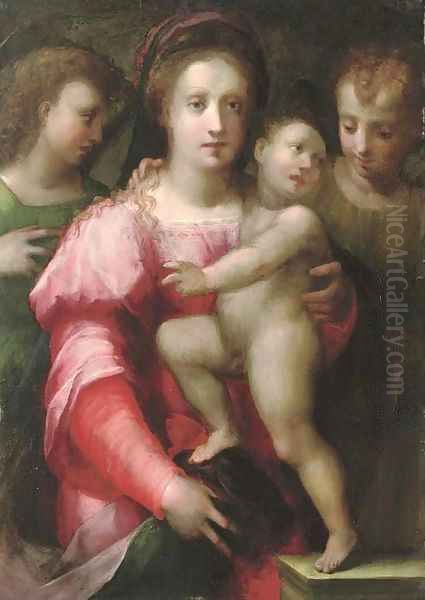
Perhaps the most recognizable trait of Puligo's paintings is their pervasive softness. He employed the sfumato technique with remarkable skill, creating gentle gradations of light and shade that model his figures with a subtle three-dimensionality. This technique avoids harsh contours, allowing figures to emerge softly from their backgrounds and fostering a sense of atmospheric unity. The faces in his Madonnas and portraits, in particular, benefit from this approach, their features rendered with a delicate haziness that enhances their beauty and often imbues them with a gentle melancholy or serene contemplation. This mastery of sfumato contributes significantly to the intimate and often dreamlike quality of his work.
Color and Light
Puligo's palette is typically warm and harmonious, favoring rich but not overly bright colors. He demonstrated a sophisticated understanding of color relationships, often using closely related tones to create a unified and pleasing visual effect. His reds, blues, and golds are often muted, contributing to the overall gentleness of his paintings. Light in Puligo's work is generally diffused, avoiding dramatic chiaroscuro. Instead, it bathes the scene in a soft glow, highlighting the tender interactions between figures and enhancing the devotional mood. This subtle use of light and color works in concert with his sfumato to create a cohesive and emotionally resonant visual experience.
Emotional Tenor and Figure Types
A defining characteristic of Puligo's art is its emotional sensitivity. His religious scenes, particularly his numerous depictions of the Madonna and Child, often with the infant St. John the Baptist, are imbued with a sense of tenderness, intimacy, and quiet devotion. The figures interact with a gentle naturalism, their gestures and expressions conveying subtle emotional states. Puligo's Madonnas are typically youthful and beautiful, characterized by oval faces, downcast eyes, and a serene, slightly melancholic demeanor. His Christ Child and infant St. John are rendered with a soft, cherubic charm. This focus on relatable human emotion made his works particularly appealing for private devotion.
Composition and Mannerist Tendencies
While rooted in the balanced compositions of the High Renaissance, some of Puligo's works exhibit subtle tendencies towards the elegance and stylization associated with early Mannerism. This might be seen in slightly elongated figures, graceful (if sometimes a little artificial) poses, and a heightened sense of refinement. However, Puligo never fully embraced the more pronounced contortions or intellectual complexities of high Mannerist artists like Pontormo or Rosso Fiorentino. Instead, his work represents a gentle transition, retaining a fundamental classicism while infusing it with a new level of sophisticated grace and emotional nuance. He was a contemporary of artists like Jacopo Pontormo (1494–1557) and Rosso Fiorentino (1494–1540), who were more radical in their departure from High Renaissance norms, and Puligo's style can be seen as a more conservative, yet still evolving, response to the changing artistic climate.
Major Representative Works
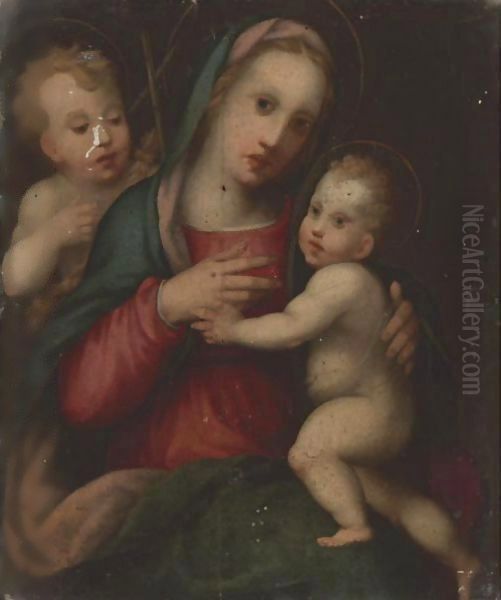
Domenico Puligo's oeuvre, though not vast due to his short career, includes several key works that exemplify his style and artistic concerns. These paintings are primarily religious in subject matter, with a particular focus on themes that allowed for the expression of tenderness and devotion.
Madonna and Child with the Infant St. John the Baptist and Two Angels
This composition, of which several versions and variations exist, is perhaps one of Puligo's most characteristic and popular subjects. These paintings typically feature the Virgin Mary tenderly holding the Christ Child, who often interacts with the young St. John the Baptist. The inclusion of attendant angels adds to the celestial, yet intimate, atmosphere. In these works, Puligo's mastery of sfumato is evident in the soft modeling of the figures' flesh and the gentle expressions on their faces. The colors are harmonious, often with a dominant warm tonality. The interaction between the children is portrayed with a charming naturalism, while the Virgin maintains an air of serene contemplation. Such paintings were highly sought after for private devotional use, and Puligo's ability to convey warmth and piety made him a favored artist for this genre.
The Holy Family
Similar to his Madonnas with St. John, Puligo's depictions of the Holy Family (Jesus, Mary, and Joseph) emphasize the intimate bonds and quiet sanctity of the sacred household. One notable example often features a green curtain as a backdrop, a common motif in Renaissance painting used to bring focus to the figures and create a sense of shallow, intimate space. In these works, St. Joseph is typically portrayed with a gentle reverence, complementing the tender interaction between Mary and the Christ Child. Puligo's skill in rendering soft draperies and conveying subtle emotional exchanges is paramount in these compositions. The overall effect is one of serene domesticity infused with a profound sense of the sacred.
Madonna and Child
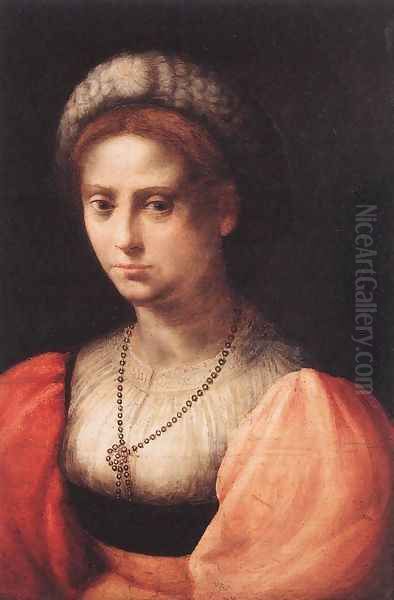
Numerous paintings by Puligo focus solely on the Virgin and Child, a theme central to Christian art and one that allowed for endless variations in pose, expression, and emotional content. Puligo's interpretations are consistently marked by their tenderness and accessibility. The Virgin is often depicted in a three-quarter pose, gazing lovingly at the Christ Child or looking outwards with a gentle, contemplative expression. The Christ Child is typically active, either blessing, reaching for his mother, or engaging the viewer with a direct gaze. These works showcase Puligo's ability to create a powerful sense of connection between the sacred figures and the viewer, making them effective aids to prayer and meditation. His delicate rendering of flesh tones and the soft fall of light contribute to their ethereal beauty.
The Vision of St. Bernard (Altarpiece, sometimes referred to in context with Pietà elements)
Among Puligo's more ambitious works is the altarpiece depicting The Vision of St. Bernard. This subject, popular in the Renaissance, shows the Virgin Mary appearing to St. Bernard of Clairvaux, a twelfth-century theologian and mystic. Puligo's interpretation would have allowed him to demonstrate his skills on a larger scale, managing a more complex composition with multiple figures. Such a commission indicates his growing reputation and ability to undertake significant public works. While the provided information links this to a "Pietà," it's more likely that the Vision of St. Bernard was the primary subject, perhaps with elements of pathos or a specific iconographic variant that evoked the sentiment of a Pietà. In such a work, one would expect to see Puligo's characteristic soft modeling and emotional depth applied to a more formal and narratively complex scene. The influence of masters like Fra Bartolomeo (1472–1517), known for his grand and spiritually resonant altarpieces, might be discernible in Puligo's approach to such a commission.
The Florentine Artistic Milieu: Contemporaries, Collaborators, and Influences
Domenico Puligo operated within one of the most dynamic and competitive artistic environments in history. Florence in the early sixteenth century was a crucible of innovation, home to established masters and ambitious young talents. Puligo's network of relationships, including his teachers, peers, and potential competitors, shaped his career and artistic trajectory.
His primary mentors, Ridolfo Ghirlandaio and Andrea del Sarto, were central figures. Del Sarto, in particular, was not just a teacher but also a benchmark of quality and a source of ongoing inspiration. Other artists in del Sarto's circle, such as Franciabigio (Francesco di Cristofano, 1482/1484–1525) and Jacopo Pontormo (in his early phase), would have been part of Puligo's immediate artistic environment. Pontormo, along with Rosso Fiorentino, would go on to become leading exponents of Mannerism, pushing stylistic boundaries further than Puligo. While Puligo's style remained more closely aligned with the classicism of del Sarto, he was undoubtedly aware of and subtly influenced by these emerging Mannerist trends, particularly in terms of elegance and refined emotional expression.
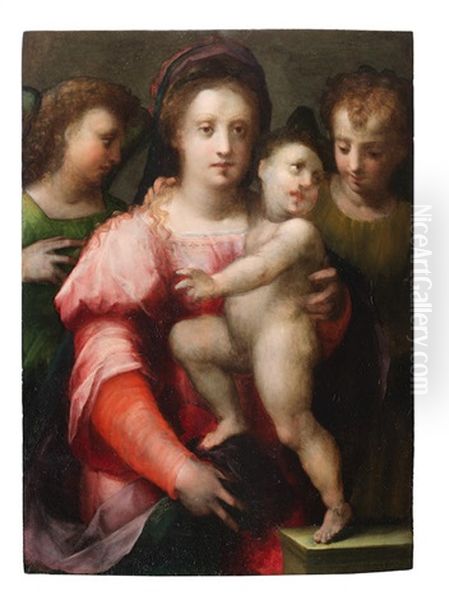
Puligo was also associated with Giovanni Francesco Rustici (1474–1554), a sculptor and painter. Both were reportedly members of a social and artistic confraternity known as the "Compagnia del Paiuolo" (Company of the Cauldron), a dining club that included artists and intellectuals. Such associations provided opportunities for discussion, exchange of ideas, and mutual support. Leonardo da Vinci (1452–1519), though of an earlier generation and largely absent from Florence during Puligo's main activity, had a profound impact on the artistic climate, particularly through his development of sfumato, which was then masterfully adapted by artists like del Sarto and, subsequently, Puligo.
The broader artistic landscape included towering figures like Michelangelo (1475–1564) and Raphael (1483–1520), whose achievements set a formidable standard for all artists of the period. While Puligo may not have directly interacted with them to a great extent, their work, particularly Raphael's Madonnas and High Renaissance compositions, formed part of the visual and intellectual currency of the time.
Puligo himself also took on the role of a teacher, with Giovanni Battista Beccari documented as one of his pupils. This indicates that Puligo had achieved a level of independent mastery and recognition sufficient to attract and train younger artists, thereby participating in the vital tradition of workshop-based artistic education. Other lesser-known Florentine painters, such as Bachiacca (Francesco Ubertini, 1494–1557), who also had connections to del Sarto's circle, would have been part of this intricate web of artistic relationships, sharing influences and competing for commissions.
Patronage and the Market for Art
The success of a Renaissance artist like Domenico Puligo depended heavily on securing patronage. In Florence, patrons ranged from wealthy merchant families and civic institutions to religious orders and private individuals seeking devotional art for their homes. Puligo's specialization in Madonnas and Holy Families catered to a strong demand for such works, which were central to domestic piety. These smaller-scale paintings would have been commissioned for private chapels, bedchambers, or as cherished family possessions.
While specific details of Puligo's major patrons are not extensively documented in the provided summary, the nature of his output suggests he found a ready market among the Florentine populace. The Medici family, though the most prominent patrons in Florence, were not the sole source of commissions. Many other affluent families, guilds, and confraternities actively commissioned art. Puligo's connection to the "Compagnia del Paiuolo" might also have facilitated introductions to potential patrons within that social circle. The commission for an altarpiece like The Vision of St. Bernard would have come from a church or a significant religious confraternity, indicating his ability to secure more substantial public projects. The general artistic climate, fostered by patrons who valued skill, beauty, and devotional efficacy, provided a fertile ground for artists like Puligo to flourish.
Later Years, Premature Death, and Legacy
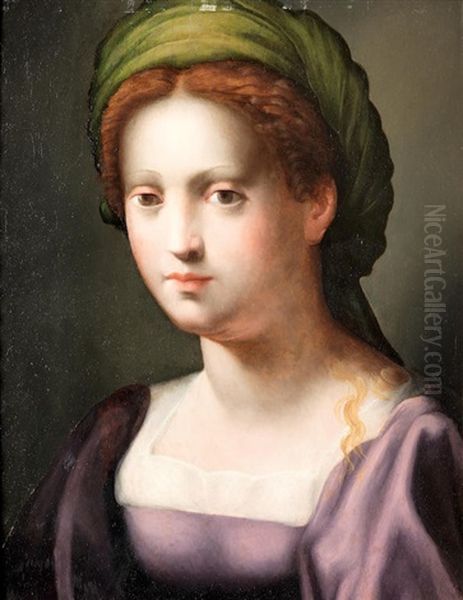
Domenico Puligo's promising career was tragically cut short. He died in Florence in September 1527, at the young age of thirty-five, a victim of the plague. This epidemic, which ravaged several parts of Italy, including Rome during the infamous Sack of Rome that same year, claimed many lives and disrupted artistic production. Puligo's premature death meant that his artistic development was curtailed just as he was reaching full maturity. One can only speculate on how his style might have evolved had he lived longer, particularly in response to the full flowering of Mannerism in Florence.
Despite his relatively brief career, Domenico Puligo left a discernible mark on Florentine painting. His works were appreciated in his lifetime, and his style, with its gentle sfumato and tender emotionality, found resonance. The art historian Giorgio Vasari (1511–1574), in his seminal "Lives of the Most Excellent Painters, Sculptors, and Architects," mentions Puligo, acknowledging his talent and his connection to Andrea del Sarto. Vasari notes Puligo's skill in coloring and his amiable personality, though he also suggests that a certain lack of ambition or an overly pleasure-seeking lifestyle might have hindered him from achieving even greater heights. Such contemporary or near-contemporary assessments, while needing to be read with a critical eye, provide valuable insights into how an artist was perceived.
Today, Puligo's paintings are held in numerous museums and private collections around the world. They are valued for their quiet beauty, their technical refinement, and their embodiment of a particular moment in Florentine art – a period of transition where the serene classicism of the High Renaissance was beginning to meld with a new sensibility characterized by elegance, grace, and a more introspective emotionalism. He may not have been an innovator on the scale of Leonardo, Raphael, or Michelangelo, nor a radical like Pontormo, but Domenico Puligo was a highly skilled and sensitive painter who made a distinctive contribution to the rich artistic heritage of his time. His ability to create images of profound tenderness and devotion continues to speak to viewers centuries later.
Conclusion
Domenico Puligo emerges from the historical record as a gifted Florentine painter whose art gracefully navigated the stylistic currents of the early sixteenth century. Trained in the solid traditions of the Ghirlandaio workshop and profoundly shaped by the "faultless" artistry of Andrea del Sarto, Puligo developed a personal style characterized by its delicate sfumato, harmonious color, and deeply felt emotional content. His Madonnas and religious scenes, imbued with a gentle piety and intimate charm, found favor with patrons and secured his place within the competitive artistic landscape of Renaissance Florence.
Though his life was cut short by the plague of 1527, Puligo's surviving works attest to a painter of considerable talent and sensitivity. He successfully absorbed the lessons of the High Renaissance, particularly its emphasis on balance, naturalism, and idealized beauty, while also subtly incorporating the emerging Mannerist taste for elegance and refined grace. His paintings offer a more accessible and perhaps less intellectually demanding counterpoint to the more intense and sometimes unsettling works of his more overtly Mannerist contemporaries. Domenico Puligo remains an important figure for understanding the nuances of Florentine art during this period of transition, an artist whose gentle touch and heartfelt depictions of sacred themes continue to resonate with quiet power. His legacy is that of a master of tenderness, a painter who skillfully translated the spiritual aspirations of his age into images of enduring beauty and grace.